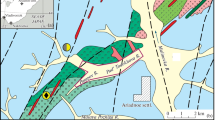Abstract
The Siratur gold deposit occurs in the northern part of the South Uralian segment of the Main Uralian Fault. The ore zone of the deposit is confined to an area of a tectonic junction of serpentinites of the Nurali massif and a longitudinal band of carbonaceous schists of the Ordovician Polyakovka Formation, which also hosts abundant basalts with petrogeochemical features of mid-oceanic ridge mafic volcanic rocks. The gold mineralization of the Siratur deposit mostly includes stringer-disseminated gold-sulfide type (1) in black shales and stringer-disseminated gold-quartz-low sulfide type (2) in listvenite–beresite complex. The microprobe analysis of gold grains showed that the fineness of type 1 and 2 gold is 670–820 and 940–970, respectively. The deposit can be ascribed to the polygenic and polychronous type.






Similar content being viewed by others
REFERENCES
Blyuman, B.A., D’yakonov, Yu.S., Krasavina, T.N., and Pavlov, M.G., Application of thermo- and X-ray characteristics of graphite for the definition of the level and type of metamorphism, Zap. Vseross. Mineral. O-va, 1974, vol. 103, no. 1, pp. 95–103.
Bushnev, D.A. and Smoleva, I.V., Carbon isotopes of organic matter from the upper Jurassic oil shales from the Volgian–Pechora shale province and its accumulation mechanisms, Dokl. Earth Sci., 2011, vol. 441, no. 1, pp. 1543–1545.
Geodinamicheskie rekonstruktsii (Geodynamic Reconstructions), Unksov, V.A, Ed., Leningrad: Nedra, 1989.
Gorbachev, O.V. and Sozinov, N.A., Some petrochemical and geochemical aspects of typization of the Precambrian carbonaceous deposits, in Problemy osadochnoi geologii dokembriya (Problems of the Sedimentary Geology of the Precambrian), Moscow: Nauka, 1985, pp. 46–57.
Kontsentratsionnye izmereniya elektronno-dyrochnykh tsentrov v kvartse metodom EPR. Instruktsiya (Concentration Measurements of Electron-Hole Centers in Quartz with Electron Paramagnetic Resonance. Manual), Moscow: Vseross. Nauchno-Issled. Inst. Miner. Syr’ya, 1986.
Krasnobaev, A.A., Valizer, P.M., and Perchuk, A.L., An Ordovician age of the dunite–wehrlite–clinopyroxenite banded complex of the Nurali Massif (Southern Urals, Russia): U–Pb (SHRIMP) Zircon Age Data, Moscow Univ. Geol. Bull., 2018, vol. 73, no. 1, pp. 166–176.
Maslov, V.A. and Artyushkova, O.V., Stratigrafiya paleozoiskikh obrazovanii Uchalinskogo raiona Bashkirii (Stratigraphy of Paleozoic Formations in the Uchaly District of Bashkiria), Ufa: Inst. Geol. Ufimsk. Nauchn. Tsentr Ross. Akad. Nauk, 2000.
Parada, S.G., The lithogenic nature of some gold deposits in carbonaceous–terrigenous sequences, Litol. Polezn. Iskop., 2002, vol. 37, no. 3, pp. 239–250.
Prudnikova, A.D., Koshchug, D.G., Vyatkin, S.V., et al., The crystallization temperature of vein quartz estimated from the concentration of the titanium paramagnetic center in quartz: A case study of the Peschanka porphyry copper–molybdenum–gold deposit, Western Chukchi Peninsula, Russia, Moscow Univ. Geol. Bull., 2017, vol. 72, no. 2, pp. 106–114.
Rykus, M.V., Snachev, V.I., Kuznetsov, N.S., et al., Ore mineralization of dunite–harzburgite and black shale formations in the transitional zone between the Southern and Middle Urals, Neftegaz. Delo, 2009, vol. 7, no. 2, pp. 17–27.
Salikhov, D.N., Rakhimov, I.R., and Moseichuk, V.M., Carboniferous collisional magmatism in the Southern Urals, in Geol. sb. № 10 (Coll. Sci. Works in Geology. Vol. 10), Ufa: DizainPoligrafServis, 2013, pp. 176–199.
Saveliev, D.E., Puchkov, V.N., Ardislamov, F.R., and Snachev, V.I., Middle Riphean volcanogenic rocks of the Mashak Formation: Geology and petrogeochemistry, Litosfera, 2009, no. 4, pp. 3–26.
Snachev, A.V., Geology and sedimentation conditions of carbonaceous deposits of the Siratur ore field, Vestn. Akad. Nauk RB, 2019, vol. 32, no. 3, pp. 15–25.
Snachev, A.V., Snachev, V.I., and Rykus, M.V., Prospects of ore-bearing carbonaceous deposits of the western frame of the Suunduk granite massif, Neftegazovoe Delo, 2010, vol. 8, no. 2, pp. 11–20.
Snachev, V.I., Snachev, A.V., and Rykus, M.V., Petrochemical features and paleogeodynamic formation conditions of the Ordovician basalts of the northern part of the Main Ural Fault (Southern Urals), Neftegazovoe Delo, 2019, vol. 17, no. 3, pp. 15–24.
Yudovich, Ya.E. and Ketris, M.P., Geokhimiya chernykh slantsev (Geochemistry of Black Shales), Moscow, Berlin: Direkt-Media, 2015. https://doi.org/10.23681/428042
Funding
This work was supported by state contract no. 0246-2019-0078. The analysis of chemical composition of minerals was supported by state contract no. AAAA-A19-119072390050-9.
Author information
Authors and Affiliations
Corresponding author
Additional information
Translated by I. Melekestseva
About this article
Cite this article
Snachev, A.V., Latypov, F.F., Snachev, V.I. et al. The Siratur Gold Deposit in Carbonaceous Rocks of an Ophiolite Association, South Urals. Moscow Univ. Geol. Bull. 75, 609–615 (2020). https://doi.org/10.3103/S0145875220060113
Received:
Revised:
Accepted:
Published:
Issue Date:
DOI: https://doi.org/10.3103/S0145875220060113



